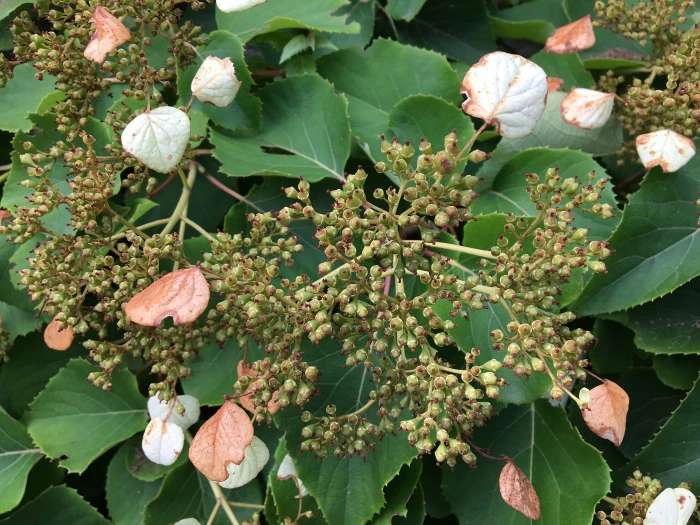Japanese Hydrangea Vine
(Hydrangea hydrangeoides)
Japanese Hydrangea Vine (Hydrangea hydrangeoides)
/
/

Plant Image Library
CC BY-SA 2.0
Image By:
Plant Image Library
Recorded By:
Copyright:
CC BY-SA 2.0
Copyright Notice:
Photo by: Plant Image Library | License Type: CC BY-SA 2.0 | License URL: https://creativecommons.org/licenses/by-sa/2.0/ | Uploader: Plant Image Library | Publisher: Flickr |






















Estimated Native Range
Climate Requirements for Millcreek, Utah
| This Plant | Your Site | Plant Suitability for Your Location | ||
|---|---|---|---|---|
| • Precipitation | 39" - 133" | 20" | Your precipitation may be insufficient for this plant. Irrigate N" / year. | Irrigate N" / year |
| • High Temp. | 64°F - 90°F | 92°F | Your summers may be too hot for this plant. | Too hot |
| • Low Temp. | 0°F - 43°F | 20°F | Your winter temperatures are normal for this plant | Excellent |
This plant should grow well at your location with about N inches per year (Y minutes per month) of irrigation.
Summary
Hydrangea hydrangeoides, commonly known as Japanese Hydrangea Vine, is a deciduous perennial vine native to the cool, moist, forested regions of Japan, Korea, and the Kuril Islands. It can climb to heights of 20-30 feet (6-9 meters) with a spread of 6-9 feet (1.8-2.7 meters), using aerial roots to attach to surfaces. The vine is known for its large, heart-shaped leaves and lacecap flower clusters that bloom in summer, featuring an array of cream, green, pink, and white flowers. The blooms are moderately showy, with the fertile flowers being small and inconspicuous, surrounded by larger, showier sterile flowers.
Japanese Hydrangea Vine is valued for its ability to add vertical interest to gardens, particularly in shaded areas where other climbers may struggle. It is often used to cover walls, trellises, or trees, providing a lush, green backdrop followed by attractive flowers. This vine prefers part shade to full shade and requires consistently moist soil with good drainage. It is relatively easy to maintain, but gardeners should ensure it does not become invasive in their region. The cultivars ’Roseum’ and ’Moonlight,’ under its synonym Schizophragma hydrangeoides, have been recognized with the Royal Horticultural Society’s Award of Garden Merit for their ornamental qualities. Potential problems include leaf spot and powdery mildew, and the vine may require pruning to control its growth and maintain its appearance.CC BY-SA 4.0
Japanese Hydrangea Vine is valued for its ability to add vertical interest to gardens, particularly in shaded areas where other climbers may struggle. It is often used to cover walls, trellises, or trees, providing a lush, green backdrop followed by attractive flowers. This vine prefers part shade to full shade and requires consistently moist soil with good drainage. It is relatively easy to maintain, but gardeners should ensure it does not become invasive in their region. The cultivars ’Roseum’ and ’Moonlight,’ under its synonym Schizophragma hydrangeoides, have been recognized with the Royal Horticultural Society’s Award of Garden Merit for their ornamental qualities. Potential problems include leaf spot and powdery mildew, and the vine may require pruning to control its growth and maintain its appearance.CC BY-SA 4.0
Plant Description
- Plant Type: Vine
- Height: 20-30 feet
- Width: 6-9 feet
- Growth Rate: Slow
- Flower Color: Cream, Green, Pink, White
- Flowering Season: Summer
- Leaf Retention: Deciduous
Growth Requirements
- Sun: Part Shade, Full Shade
- Water: Medium
- Drainage: Slow, Medium, Fast
Common Uses
Bank Stabilization, Bee Garden, Butterfly Garden, Drought Tolerant, Fragrant, Rabbit Resistant, Salt Tolerant
Natural Habitat
Cool, moist, forested regions of Japan, Korea, and the Kuril Islands
Other Names
Common Names:
Scientific Names: Schizophragma hydrangeoides, Hydrangea hydrangeoides, Schizophragma hydrangeoides f. molle, Schizophragma hydrangeoides var. concolor, Hydrangea taquetii, Cornidia integerrima, Schizophragma hydrandeoides, Schizophragma hydrangeoides f. concolor, Schizophragma hydrangeoides f. mollis
GBIF Accepted Name: Hydrangea hydrangeoides (Siebold & Zucc.) Bernd Schulz